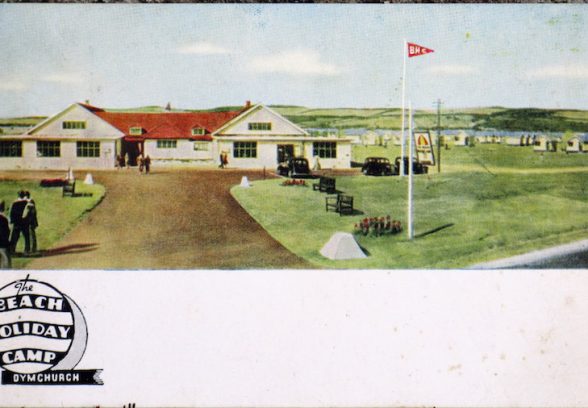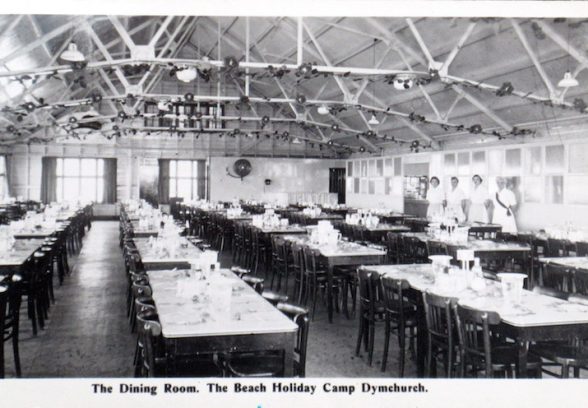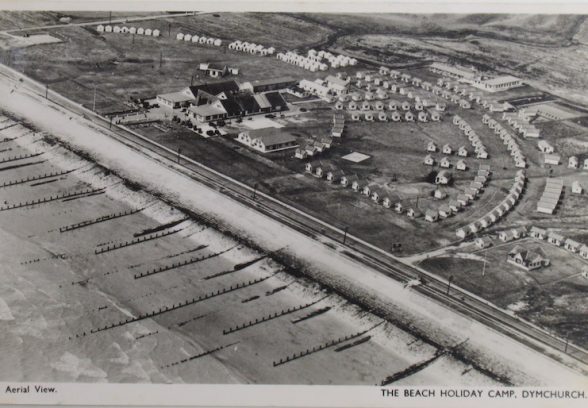This website uses cookies
This website uses cookies to enable it to function properly and to analyse how the website is used. Please click 'Close' to accept and continue using the website.






September 2017 - Beach Holiday Camp Clubhouse, Dymchurch, Kent
by Sam Hawksford White
It is with regret that I have to report that one of the earliest purpose built holiday camp buildings remaining in the country is at risk of demolition following approval of a planning application to replace the structure. Built in 1936, the clubhouse is a rare survival of 1930s holiday camp architecture that has escaped substantial alteration despite requisition for use as an army training camp during the war, but probably will not be standing for much longer.
Set back just one hundred yards or so from the beach, the clubhouse was designed with direct road access, and has been claimed as the first ‘motel’ in the UK, complete with covered garage accommodation for a small number of vehicles. Newly arriving holidaymakers would have approached the camp by car or local bus along a long stretch of seafront road, before turning onto a forecourt that was bordered with formal planting, mirroring the dimensions of the building exactly, and framing its distinctive three-gabled front elevation.
Structurally, the clubhouse is composed of two long bays with pitched, slated roofs, linked together to form a H-plan, the entire design reflecting an engagement with Arts and Crafts domestic design in its steep roofs and miniature dormer windows. Below roof level, there are regular interruptions in the cream painted walls for well-proportioned metal window openings, which are shown as having green glazing bars in contemporary promotional material.
The two principle rooms, the dining hall and the ball room, were originally open to roof height, supported by a rather elaborate web of steel trusses (now unfortunately concealed by modern suspended ceilings), and as a result the halls would have originally been generous in their proportions, light and airy with side doors opening out onto the putting green, tennis courts and wider camp beyond. Yet, the building was ‘comfortably warmed by central heating should the weather turn chilly’ as early as 1946.
Also containing a licensed club and bar, plus a games room and sun lounge with fitted furniture, the camp clearly went to great effort to adapt its buildings after the war ended, and all of its chalets and tents were lit with electric lighting: ‘Don’t think for a moment that they are just ordinary army tents! Far from it!’.
1930s photographs show the dance hall decorated with coloured bunting hanging down from the roof trusses, and featured a wide horizontal window on the front gable and an imported Canadian sprung maple floor, which is retained in the pavilion today. If the recently inserted ceilings were to be removed, this room could certainly be returned to its former glory, and there is great potential for careful restoration, extension and continued use. For such an apparently slightly built structure to survive over eighty years of continuous summer use is remarkable, and it is clear that the significance of the clubhouse as an early example of its building type has been much overlooked. As it stands, however, we are left with damaging proposals to replace a significant but unlisted building with a new ‘complex’ of similar footprint but negligible architectural interest.
It is of great concern that the present owners of the holiday camp intend to replace this fine clubhouse, we think that it deserves much better having promoted itself in such a cheerful manner:
‘If you want a quiet restful holiday, with perhaps a trip or two to surrounding beauty spots, with sun-bathing, reading, in fact just lazing around and doing just what you want as and when you wish … rest assured that no super-energetic camp major-domo is going to disturb you … Freedom is the keynote of the whole place – The Choice is YOURS. But if you want Sports, Amusements, Exercise, Dancing, Gymkhanas, or any of the hundred-and-one holiday activities, they are here for you to enjoy – The Choice is YOURS’.
Sam Hawksford White is studying for the MSt in Building History at the University of Cambridge.
Look for past Buildings of the Month by entering the name of an individual building or architect or browsing the drop down list.

Become a C20 member today and help save our modern design heritage.